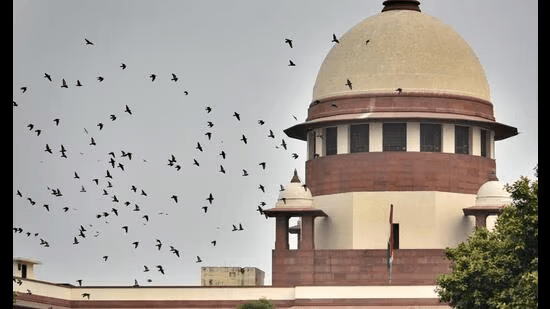At the heart of the Supreme Court marriage equality hearings lie a host of patriarchal anxieties over the challenge to the definition of family

Nobody can predict which way the courts will rule. But to listen to the proceedings, is to hear the story of a nation where people fall in love and dream of building lives and setting up their own families. It is to hear of what senior advocate Saurabh Kirpal calls “lavender marriages”, where gay men are married off to women under family pressure. (Biplov Bhuyan/HT PHOTO)
So far, the objection to marriage equality has been roughly on two grounds. The first, it is the job of Parliament to debate and legislate on the matter. And the second, marriage is a union between “biological” men and women with the intent to procreate; those asking for marriage rights represent an “urban elitist” point of view that is divorced from the reality of India.
Of course, there are other objections. Gay parents can’t be good parents, is the astounding, and baseless, claim of the National Commission for the Protection of Child Rights (NCPCR). And then there’s the new entrant to the Objector’s Group, the Bar Council of India, with views that uncannily echo the government of India.
Parliaments in voting democracies are often motivated by majoritarian opinion. But populist views do not always align with constitutional rights. As former attorney general, Mukul Rohatgi told the court: “I cannot be discriminated against because we may be 10,000 and the others are 10 crore.”
You don’t have to go back far in history to know how the courts have stepped in when Parliament has hesitated. It was the courts that first ruled on triple talaq in October 2017 before Parliament enacted a law two years later. It was the courts that issued the Vishakha guidelines against workplace sexual harassment 16 years before Parliament, prompted by public protests, finally enacted a law in 2013.
Unstated in these objections lie a host of patriarchal anxieties. At the heart of the marriage equality petitions is marriage obviously, but, going beyond this, the issue fundamentally touches the definition of family itself.
At present, the law defines family as the one you are born into (the natal family), which would include legally adopted children, and the one you marry into (the marital family).
Banded together somewhat lazily as “same-sex marriage”, the 52 petitioners each have different stories. Some have legally recognised marriages abroad and have even adopted children together but find that in India their union has no legal status.
“Same sex” doesn’t even apply to petitioners, including transpersons and intersex people who want the court to expand the traditional definition of family. Far from “urban elitist”, these young people in small towns and villages are being forcibly married off, beaten, locked up or thrown out of the family and forced to beg.
When the family is the primary source of violence, shouldn’t citizens have the right to choose their families, asked senior advocate Vrinda Grover. Grover is representing a client whose choices are not respected by her family. The client suffers from poor health but knows that life-or-death decisions will be made for her by this legally recognised family and not those she loves and trusts. Should she not have the right to choose her family?
We need, Grover urged the court, a “new imagination of marriage and family which is based on love, care and respect.”
Transpersons already have families; they are in relationships and have adopted children, but these are not recognised by the law, said senior advocate Jayna Kothari. “Is a family different just because your gender identity is different?”
The bench is proceeding with caution. It has set the limits of change–should it come–by restricting the hearing to the Special Marriage Act (SMA) enacted in 1954 for interfaith marriages. It will not get into personal law. It will not even get into the “nitty gritty” of adoption, inheritance etc, which are governed by personal law, as clarified to senior advocate Maneka Guruswamy on day four of the hearings.
Yet, even this truncated concession is unlikely to assuage fears in a country where 93% of Indians, regardless of their sexual orientation, still marry the way their parents did i.e. through arranged marriages in keeping with faith and caste endogamy, according to a 2018 survey by the Lok Foundation-Oxford University administered by the Centre for Monitoring Indian Economy.
The idea of any two people falling in love continues to be so radical in modern India that it can, and does, lead to so-called honour killings. The thought that a daughter might run off with the wrong kind of man leads to severe curtailment of her movements. The concept of an interfaith marriage is so alarming that it has resulted in laws in several states that virtually make it impossible for Hindus and Muslims to marry.
If inter-caste, inter-faith love marriages amongst heterosexual couples cause such consternation, can you imagine the alarm bells ringing over the very idea of marriage equality?
Nobody can predict which way the courts will rule. But to listen to the proceedings, is to hear the story of a nation where people fall in love and dream of building lives and setting up their own families. It is to hear of what senior advocate Saurabh Kirpal calls “lavender marriages”, where gay men are married off to women under family pressure.
It tells you that people don’t want to lead these duplicitous lives any longer. It tells you that we don’t choose our sexual orientation any more than we choose to be right-handed or left. It tells you that love just happens, and you can only hope that it will find a way.
Namita Bhandare writes on gender.
The views expressed are personal.